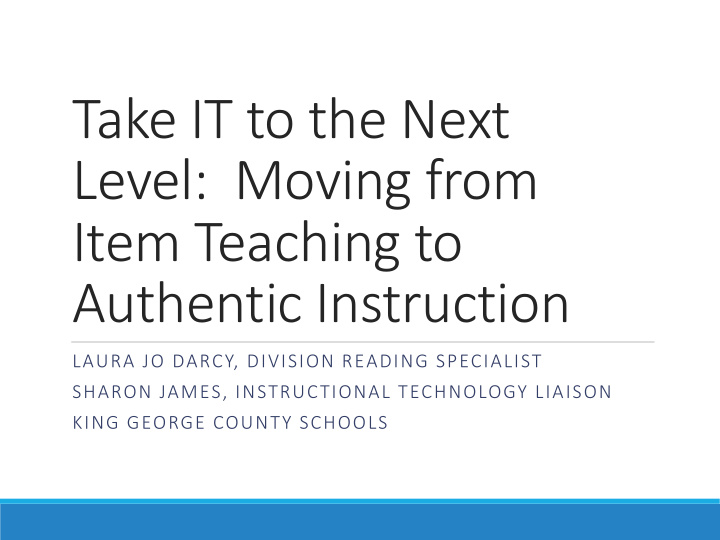



Take IT to the Next Level: Moving from Item Teaching to Authentic Instruction LAURA JO DARCY, DIVISION READING SPECIALIST SHARON JAMES, INSTRUCTIONAL TECHNOLOGY LIAISON KING GEORGE COUNTY SCHOOLS
Inauthentic Teaching & Item Teaching (IT) The work students do does not allow them to use their minds well. The work has no intrinsic meaning or value to students beyond achieving success in school. Newman, F. M. & Wehlage, G. G. (1993). Five standards of authentic instruction. Educational Leadership, 50 (7), 8-12.
Session Goal To provide examples, resources, and motivation to support authentic instruction and meaningful formative assessment ◦ Higher-Order Thinking ◦ Depth of Knowledge ◦ Connectedness to the World ◦ Substantive Conversation ◦ Social Support for Student Achievement Newman, F. M. & Wehlage, G. G. (1993). Five standards of authentic instruction. Educational Leadership, 50 (7), 8-12.
Authentic Instruction Cycle Transformation • Text is ALWAYS central • Authentic tasks make to the lesson. student thinking • Understand author's visible. message. • Student thinking vs. • Analyze author's author's thinking message. • Create new Formative Text representation. Assessment
Resources/Strategies ◦ Read-List-Group-Label ◦ Word Talks ◦ Plickers ◦ Graphic Organizers with Google Classroom
Read & List List-Group-Label is typically used as a BEFORE reading strategy. Students do not always have the background knowledge to brainstorm words that are relevant to an unfamiliar topic. We modified the strategy to incorporate reading of introductory text (Civil Rights poetry) as a source of words for the List phase of the strategy. In this way, the strategy became a DURING and AFTER reading strategy that had students examining text for powerful words and grouping words according to important themes.
Group & Label
Group & Label
Group & Label
Group & Label
Word Talks ◦ Individual Response: What do you know about the word? ◦ Partner/Table Sharing and Discussion ◦ Whole Group Debriefing: What do WE know about the word? ◦ Revisit personal maps
Word Talk: desegregation
Word Talk: desegregation
Word Talk: integration
Word Talk: unbreakable Video clip of 4 th grade students
Plickers Classroom response systems can be used for more than just Item Teaching… ◦ Conceptual Understanding Questions ◦ Application Questions ◦ Critical Thinking Questions ◦ Student Perspective Questions ◦ Confidence Level Questions (Self-Evaluation) ◦ Progress Monitoring Questions ◦ Classroom Experiments http://cft.vanderbilt.edu/guides-sub-pages/clickers/#questions
Plickers: Student Perspective
Plickers: Anticipation Guide (Confidence Level Question)
Plickers: Determining Importance in Text (Application Question)
Plickers: Student Self- Monitoring
Open-Ended Graphic Organizers and Google Classroom
If NOT item teaching, then WHAT ? 1. Read extensively during instruction. 2. Provide many opportunities for unsupported reading and response. 3. Include texts “rich in content and sufficiently challenging.” 4. Require students to justify responses with text evidence. 5. Engage students in responding to text beyond multiple-choice questions, especially through writing. Shanahan, T. (2014). How and how not to prepare students for the new tests. The Reading Teacher, 68 (3), 184-188.
Instructional Strategies Read-List-Group-Label (modified from List-Group-Label) http://www.readingrockets.org/strategies/list_group_label Word Talks http://readingpassadvanced.blogspot.com/p/word-talks.html Plickers www.plickers.com Google Classroom Demonstration http://youtube.com/watch?v=K26iyyQMp_g
Free Sources of Text Passages Text Project- FYI for Kids http://textproject.org/classroom-materials/students/fyi-for-kids/ ReadWorks www.readworks.org Tween Tribune www.tweentribune.org Newsela www.newsela.org CommonLit www.commonlit.org
Bibliography Newman, F. M. & Wehlage, G. G. (1993). Five standards of authentic instruction. Educational Leadership, 50 (7), 8-12. Shanahan, T. (2014). How and how not to prepare students for the new tests. The Reading Teacher, 68 (3), 184-188.
Disclaimer Reference within this presentation to any specific commercial or non-commercial product, process, or service by trade name, trademark, manufacturer or otherwise does not constitute or imply an endorsement, recommendation, or favoring by the Virginia Department of Education.
Contact Us Laura Jo Darcy, Division Reading Specialist ldarcy@kgcs.k12.va.us Sharon James, Lead Instructional Technology Liasion sjames@kgcs.k12.va.us
Recommend
More recommend